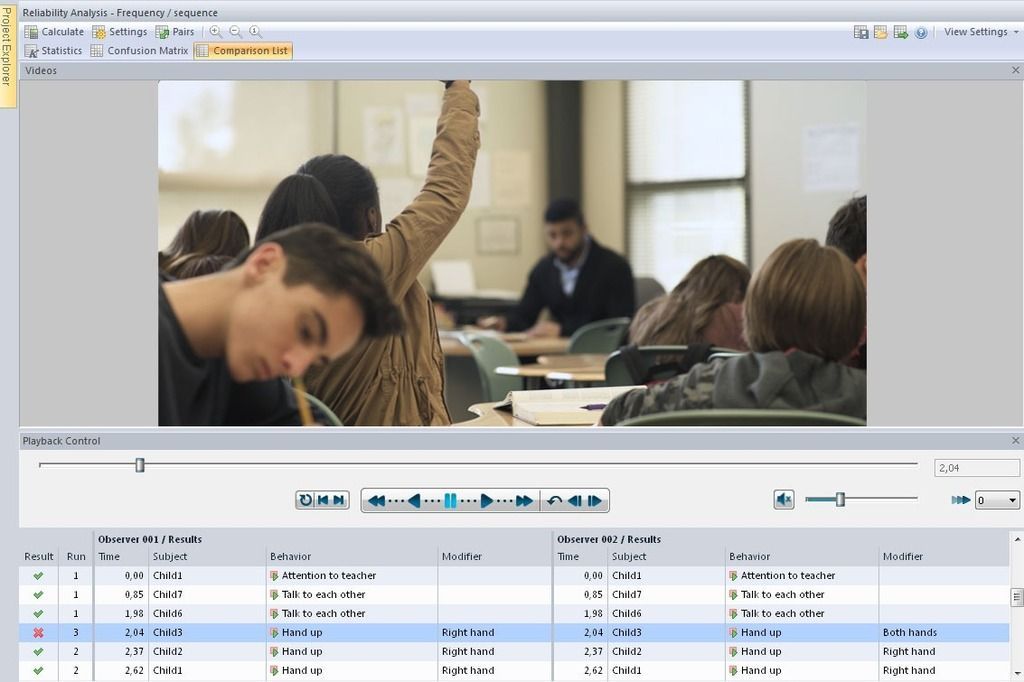7 tips to make coding behavioral data more fun
Coding behavioral data helps to understand what your data represents. But let's face it, it isn't much fun to do and it takes a lot of time. Here are 7 tips to make the coding process more effective.
Posted by
Published on
Wed 24 Nov. 2021
Topics
| Coding Behavior | Coding Schemes | Infants | Parent-child Interaction | The Observer XT | Video Recording |

Human behavior consists of many aspects, which are worthwhile to investigate. Doing research is to understand why things happen and what relationships between phenomena are. For example, parent-child interactions, language development, handedness, and mealtime behaviors are well-known topics in developmental psychology research.
FREE WHITE PAPER: Tools for infant studies
Learn more about the software tools available for infant studies.
- Capture behaviors with video
- Annotate behaviors accurately
- Unobtrusive emotion analysis
As a researcher who works with children and their parents or caregivers, you know that part of your job is to record the experiment, review the sessions, and code numerous videos of your participants. Especially the coding part is a time-consuming, but necessary activity.
Why is coding behavioral data important?
Coding videos will help you summarize and highlight important pieces of information that are essential for the analysis of the observed behavior. You will be looking for frequencies, durations, sequences, similarities, or differences with respect to what participants say or what participants do.
Behavioral coding supports quantifying qualitative data and gives sense to your raw data. It categorizes your data meaningfully and helps to understand what it represents.
7 tips to make coding behavioral data more fun
But let's face it, coding isn't much fun to do and it takes a lot of time. Tips to make coding behavioral data more effective and a bit more enjoyable are therefore more than welcome.
1. Keep your research questions in mind
To keep focused and to prevent doing work that ends up not being used in the analysis, it is wise to stick to the components which will answer your research questions. Not all behaviors that your participants show on the video will be equally good for this purpose.
Be sure to make considered choices in what is important and what is not. Constantly keep referring back to your research questions.
2. Use a coding scheme
As you code more and more data, it can be hard to remember all of your codes off the top of your head. A coding scheme helps keep you organized throughout the data analysis process. In addition, you give the other members of the research team insight into which behaviors are coded and how. It ensures transparency.
However, creating a scheme for behavioral coding is not as straightforward as it may seem. It often requires quite some thinking to define the perfect scheme for behavioral coding. Keep in mind that once it’s ready, you will benefit a lot from the energy you put into drawing up the coding scheme.
FREE WHITE PAPER: How to set up a coding scheme
Download here the FREE white paper 'How to set up behavioral coding' and get 7 tips about:
- Defining your behavior group
- Point events
- Coding from a diversity of sources
3. Select a few videos to find common codes
Depending on the size of your sample you can select, for example, 10% of your videos to get a first impression what emerges from your data. You don’t want to do this with all your videos, since that is very time consuming. Selecting a smaller number of videos can give you your set of common codes to look for in the rest of the data. Although you should keep in mind that you might come across things that you did not expect.
4. Document why you make certain choices
Be thorough in documenting the coding process and especially how the codes fit together. This proves that the process is transparent, which contributes to your credibility.
Put in your memos whether you noticed something that was expected based on your literature review or whether you learned something totally new. What patterns or contradictions are emerging that you’re noticing while coding? This gives you a log of your coding process and also helps you write the first draft of your final report. Another win.
5. Divide the coding work
Once you’ve created a solid coding scheme the next step you can take is to invite others to help you with the coding work. Diving this large amount of work prevents workload and stress. Multiple people can work on coding at the same time, speeding up the entire process.
In such collaboration, avoiding observer bias is, of course, crucial. Reliability analysis assesses the extent to which two observations are in agreement with each other and helps determining when your co-workers are ready for the real work.

6. Check out sources of information about coding behavioral data
In the blog post ‘Behavioral coding: What and how’ you can read more about the benefits and how to use behavioral coding.
Or watch the Technical Briefing ‘Behavioral Coding - Designing optimal coding schemes in The Observer XT’, in which we will show you how to create coding schemes that allow you to reach your behavioral endpoints but, at the same time, are clear enough for efficient and reliable coding.
The practical guide in the article ‘Developing and Modifying Behavioral Coding Schemes in Pediatric Psychology’ can also be useful.
7. Smile while you are coding
Surely, this header immediately put a smile on your face. A smile is very powerful, we enjoy things more when smiling. Besides, smiling can reduce stress since it decreases hormones such as cortisol and adrenaline, and it can lower blood pressure. The muscles used while smiling trigger your brain to produce more endorphins and provide a sense of well-being. This will make your coding work much more fun!
Behavioral coding software
A great tool that can help you with your coding and analysis work is The Observer XT. It supports the entire workflow of your research project. The software offers many benefits and meets your requirements:
- The Observer XT guides you through the process of creating a coding scheme. Want to add behaviors? The software shows an example of the kind of results you can expect.
- While coding, you can use shortcut key codes to keep up the speed. The time of each code is recorded automatically and errors are stopped by an online check.
- The Observer XT uses smart coding; when starting one event you do not have to stop the previous event of the same group, one cannot run and stand still at the same time.
- Both time (instantaneous) sampling and continuous recording are available as sample methods.
- You can use the playback functions to easily position the video, play it back at different speeds, play it frame by frame, and play multiple videos in sync at the same time to ensure accurate coding of the behaviors.
- You can set a loop in the video and audio files to code this particular episode in great detail, or use the quick review button to take a small step back in the video.
- Combining data from different sources in your observation, such as eye trackers or physiological measurements is no problem at all.
- With the coder licenses you can work with multiple people on the same research project, which saves you lots of time. With the reliability analysis, observer bias can be avoided.
FREE TRIAL: Try The Observer XT yourself!
Request a free trial and see for yourself how easy behavioral research can be!
- Work faster
- Reduce costs
- Get better data
References
- MacLaren Chorney, J.; McMurtry, C.M.; Chambers, C.T. & Bakeman, R. (2015). Developing and Modifying Behavioral Coding Schemes in Pediatric Psychology: A Practical Guide. Journal of Pediatric Psychology, 40(1), 154–164. https://doi.org/10.1093/jpepsy/jsu099
- How to Know You Are Coding Correctly: Qualitative Research Methods
- What is a Code?: Qualitative Research Methods
- The Cycles of Coding: Qualitative Research Methods
- Smile: A Powerful Tool
Related Posts

Observing behavior - Jury deliberations, what happens behind closed doors

How to measure infant behavior
